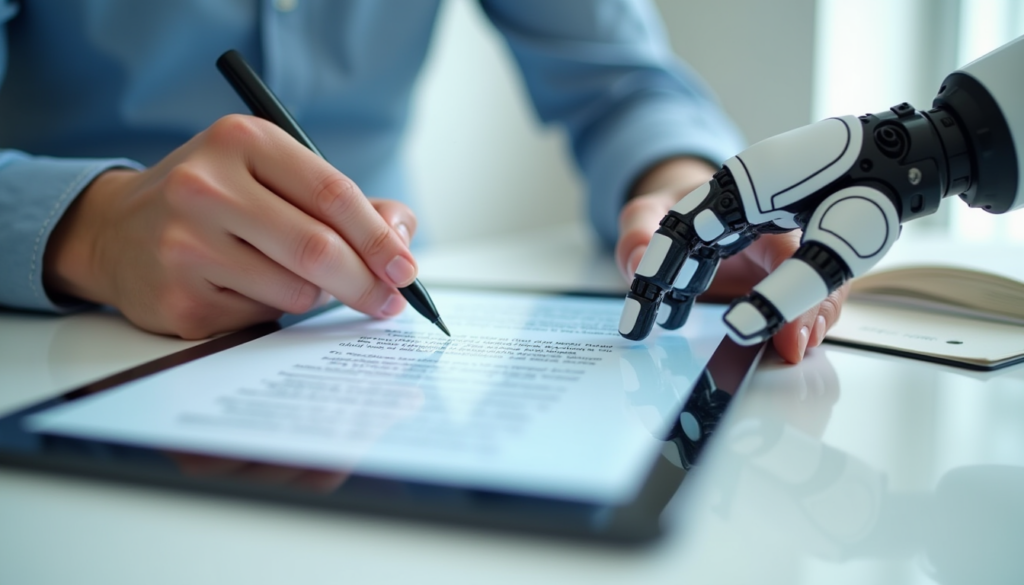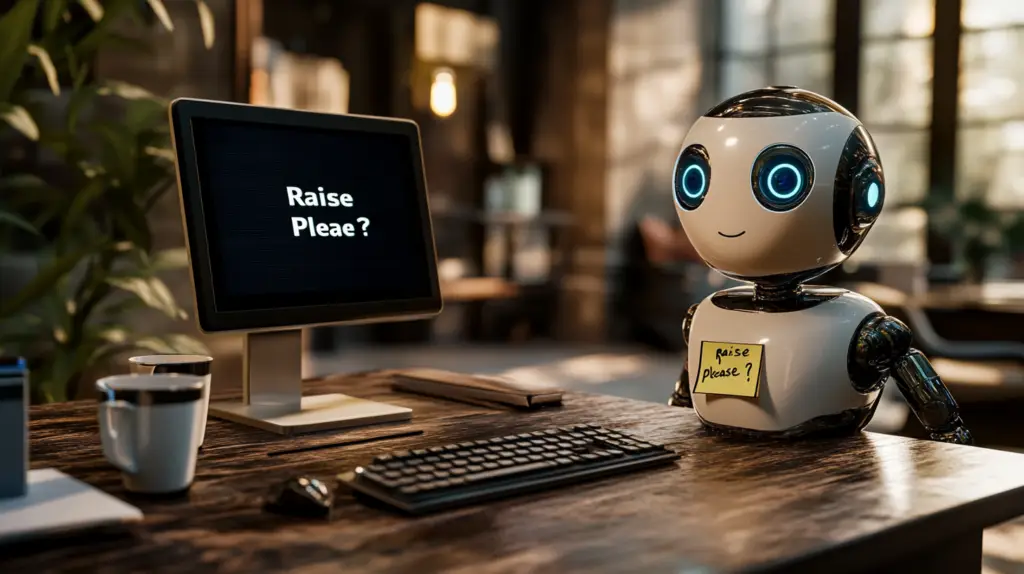According to recent research from Gartner, 30% of marketing departments now use some form of AI automation in their content creation process. First, let me tell you a little secret: this article might have been written by an AI, or maybe a human, or perhaps some caffeine-fueled collaboration between the two. Next, as you’re reading this, you might start wondering if you can tell the difference anymore. For example, that statistic I just mentioned? An AI could have found that in seconds, while I would have spent 20 minutes going down a research rabbit hole and another 10 minutes checking social media. In the same way that robots transformed manufacturing, AI automation is now infiltrating the creative world of copywriting—though thankfully with fewer apocalyptic warnings from sci-fi movies.
The relationship between copywriters and AI tools has evolved from skepticism to a strange form of co-dependency. Even so, many professionals still wonder: Will these silicon-brained assistants eventually make human creativity obsolete, or are they just really good at helping us brainstorm while we take credit for their ideas?
The Evolution of AI Automation in Copywriting

The journey of copywriting has progressed from typewriters to terminators—well, not quite terminators, but certainly some impressively clever algorithms. Initially, copywriters relied on thesauruses and coffee to fuel their creativity. Then, spell-checkers arrived to save us from embarrassing typos. Following this, grammar tools emerged to rescue us from the perils of passive voice. As a result of this gradual progression, we’ve now arrived at AI systems that can generate entire marketing campaigns while we contemplate our career choices.
Research published in the Journal of Marketing Communications shows that AI automation in copywriting has grown by approximately 200% since 2020. For this reason, companies are investing heavily in these technologies. In fact, according to a 2023 survey by the Content Marketing Institute, 62% of marketing teams now use some form of AI to assist with content creation.
“The capabilities of AI language models have advanced to the point where they can generate contextually relevant, brand-aligned copy that often passes the human test,” explains Dr. Sarah Chen, AI researcher at MIT Media Lab. “What’s more, they can do it in seconds rather than hours.”
Meanwhile, traditional copywriters are either frantically updating their LinkedIn profiles or learning to become AI prompt engineers—sometimes both simultaneously, which requires impressive multitasking skills.
How AI Automation Is Transforming the Copywriting Process: The Good, The Bad, and The Hilarious
AI automation is currently being used for various copywriting tasks with varying degrees of success. For example, product descriptions have become a prime target for automation. In contrast, more nuanced content like brand storytelling still benefits from a human touch.
Email subject lines are another area where AI automation shines. With this in mind, it’s worth noting that the algorithm doesn’t experience the existential dread that humans feel when writing “RE: Following up on my previous email” for the fifth time.
Similarly, AI can generate dozens of social media post variations in minutes. To illustrate this point, consider how many different ways an algorithm can tell you to “like and subscribe”—likely more than any human would have the patience to brainstorm.
However, AI automation still has its limitations. Due to its reliance on existing data, it sometimes struggles with truly innovative concepts. While humans might experience writer’s block, AI experiences what we could call “originality block.”
“I once asked an AI to write copy for a new type of biodegradable water bottle,” shares Marcus Lee, Creative Director at Firestarter Agency. “Instead, it gave me content that seemed to be for a bottle made entirely of liquid, which would defeat the purpose entirely. That day, I felt secure in my job.”
The Human-AI Partnership in Modern Copywriting: A Complicated Relationship
The relationship between copywriters and their AI assistants can best be described as “it’s complicated.” First of all, humans provide strategic direction and emotional intelligence. Then, AI handles the heavy lifting of generating options and variations. Following this collaboration, humans step back in to refine and approve.
Professor Emily Rodriguez from Stanford’s Digital Marketing Department compares it to a dance: “The human leads with creative strategy, the AI follows with rapid generation, then the human leads again with refinement. Such partnerships work best when each partner knows their role.”
To work effectively with AI tools, copywriters need to develop new skills. For instance, prompt engineering—the art of giving AI clear instructions—has become as important as writing itself. In the same way, understanding an AI’s capabilities and limitations helps manage expectations.
Case studies of successful human-AI collaborations are emerging across industries. For example, when Shoeline.com implemented AI for product descriptions, they increased their production rate by 700%, according to research published in the Harvard Business Review. With this in mind, they still maintained a human editor to add brand personality and check for factual accuracy.
“My AI assistant and I have developed a working relationship similar to an old married couple,” jokes Tom Richards, Head of Copy at Digital Dreams Agency. “I know exactly what will confuse it, and it seems to deliberately misunderstand me when I’m in a hurry. Still, I can’t imagine working without it now. It’s like having an intern who never needs coffee breaks but occasionally thinks it’s a good idea to describe shoes as ‘foot prisons.'”
Implementing AI Automation in Your Copywriting Workflow Without Losing Your Mind

Integrating AI automation into your copywriting process requires careful planning. First, identify repetitive writing tasks that could benefit from automation. Next, select AI tools that align with your specific needs. Then, establish clear workflows for how AI-generated content will be reviewed and refined.
Jake Matthews, Digital Marketing Manager at TechSolutions, offers this advice: “Start small. Don’t try to automate your entire content production overnight. Begin with something simple like email subject lines or meta descriptions. As a result, you’ll build confidence in the process.”
Training your AI with your brand voice is crucial for consistent results. To do this effectively, provide the AI with examples of your best work, clear brand guidelines, and regular feedback on its output. With this approach, the AI learns your style over time.
Common pitfalls when implementing AI automation include:
- Overreliance: Expecting the AI to do everything without human oversight
- Undertraining: Not providing enough examples for the AI to learn your brand voice
- Scope creep: Trying to automate content that requires deep human empathy or creativity
“I once made the mistake of letting our AI write our entire monthly newsletter without review,” confesses Rachel Torres, Content Manager at HealthBright. “It enthusiastically announced our company’s expansion into ‘untapped markets like Mars and Atlantis.’ Since then, we’ve implemented a strict review process.”
Ethical Considerations: When Your AI Copywriter Develops a Conscience
As AI automation becomes more prevalent in copywriting, ethical questions arise. For instance, should content created primarily by AI be disclosed to audiences? Similarly, who owns the copyright to AI-generated content?
According to a 2023 survey by the Content Ethics Institute, 73% of consumers believe companies should disclose when content is created using AI. Due to this expectation, transparency may become a competitive advantage rather than just an ethical choice.
“The attribution question is particularly thorny,” notes Dr. Mark Jameson, Professor of Digital Ethics at Cambridge University. “If an AI generates a brilliant marketing slogan based on analyzing millions of human-created phrases, who deserves credit? The AI developers? The copywriter who prompted it? The original creators whose work trained the AI?”
Maintaining authenticity in automated content is another challenge. For example, when an AI writes in the voice of a CEO or brand founder, is this an acceptable form of ghostwriting or a form of digital impersonation?
“I once received what appeared to be a heartfelt email from a company founder, thanking me for my years of loyalty,” shares consumer advocate Lisa Brentwood. “The message felt personal until I received an identical email from three other companies that same day, all clearly using the same AI template. Even so, I appreciate the sentiment—I just wish it felt more genuine.”
Addressing biases in AI-generated copy requires constant vigilance. Because AI tools learn from existing content, they can perpetuate stereotypes or problematic language patterns. Human reviewers must screen for these issues before publication.
The Future of AI Automation in Copywriting: Preparing for the Revolution
Emerging trends in AI copywriting suggest the technology will become increasingly sophisticated. For instance, multimodal AI systems that can create coordinated text and visual content are already in development. In the same way, AI tools that can tailor copy for specific psychological profiles represent the next frontier in personalization.
“The next generation of AI copywriting tools will not just generate text but entire integrated campaigns,” predicts technology futurist Dr. Aisha Johnson. “They’ll create the copy, design the visuals, optimize for different platforms, and even predict performance—all working together seamlessly.”
For copywriters looking to stay relevant, developing strategic and creative thinking skills is essential. While AI excels at generating content based on patterns, humans still lead the development of innovative concepts and emotional storytelling. As a result, copywriters should focus on these higher-level skills.
“Future copywriters won’t compete with AI on production volume or speed,” explains recruitment specialist Carlos Mendez. “They’ll distinguish themselves through strategic insight, brand stewardship, and the ability to connect with audiences on a human level that AI still struggles to authentically replicate.”
Measuring the Impact of AI Automation on Copywriting ROI: Numbers Don’t Lie, But AI Might
When implementing AI automation in copywriting, tracking the right metrics is crucial for evaluating success. For example, consider measuring:
- Production efficiency (time saved per content piece)
- Content engagement metrics (comparing human vs. AI-assisted content)
- Conversion rates and ROI
- Brand consistency scores
- Team satisfaction and creative fulfillment
Research from the Content Marketing Institute shows that teams using AI automation effectively can increase content production by up to 300% while reducing costs by 37%. Due to these efficiency gains, teams can focus more on strategy and creative direction.
“We thought implementing AI would be all about cost-cutting,” shares Jennifer Kim, Marketing Director at GreenLife Products. “Instead, it transformed how we allocate our creative resources. Our writers now spend 60% more time on high-impact creative projects because the AI handles routine content needs.”
Finding the right balance between efficiency and quality requires ongoing adjustment. For instance, some companies maintain a “human-guaranteed” tier of content for their most critical communications while using AI-assisted content for higher-volume needs.
“The best results come when you stop thinking about it as human versus machine,” advises content strategist Miguel Santos. “Think of it as finding the right blend of both for each specific content need. Sometimes that’s 90% human and 10% AI, and sometimes it’s the reverse.”
Frequently Asked Questions About AI Automation in Copywriting (That Won’t Make Your AI Assistant Roll Its Eyes)
Q1: Will AI automation completely replace human copywriters?
Despite advances in AI technology, human copywriters bring unique creative insights, emotional intelligence, and strategic thinking that AI still cannot fully replicate. Rather than replacement, the industry is moving toward collaboration, with AI handling routine tasks while humans focus on creative direction and strategy. According to a 2023 McKinsey report, only about 30% of copywriting tasks can be fully automated with current technology.
Q2: How much does it cost to implement AI copywriting tools?
Costs vary widely based on the sophistication of the AI and your organization’s needs. Entry-level AI writing assistants start around $20-50 per month per user, while enterprise-level solutions with advanced features can cost thousands monthly. However, many companies report ROI within 3-6 months through increased productivity and content output.
Q3: Do audiences respond differently to AI-generated content?
Research from Northwestern University shows that audiences generally cannot distinguish between human-written and AI-generated content when the AI content is properly edited and refined. However, studies also indicate that purely AI-generated content may lack the emotional resonance or unique voice that creates brand loyalty over time.
Q4: What types of copywriting are best suited for AI automation?
Content types that follow predictable structures require data integration or need multiple variations to work well with AI automation. These include product descriptions, email subject lines, social media posts, SEO-focused blog content, and personalized marketing messages. Content requiring deep emotional connection, original creative concepts, or brand positioning statements still benefits from significant human input.
Q5: How do I train an AI to write in my brand’s voice?
Effective training requires providing the AI with clear brand guidelines, multiple examples of your existing content, key terminology, and consistent feedback on outputs. Many platforms allow you to create custom models or “tones” based on your inputs. The training process is ongoing, with performance improving over time as the system receives more examples and feedback.
Q6: What skills should copywriters develop to work effectively with AI?
Modern copywriters should develop skills in prompt engineering (giving clear instructions to AI), content strategy, brand guardianship, emotional intelligence, and critical editing. Understanding how AI tools work—and their limitations—helps copywriters use them more effectively while maintaining creative control.
Q7: Is it ethical to use AI-generated content without disclosure?
Ethical standards around AI content disclosure are still evolving. Most ethical guidelines suggest transparency when AI plays a significant role in content creation, particularly for sensitive topics or when personal connection is implied. Some industries and platforms have begun implementing specific disclosure requirements for AI-generated content.
Q8: How can I ensure AI-generated copy doesn’t contain biases or inaccuracies?
Human review remains essential for quality control. Implement a review process that checks for factual accuracy, brand alignment, and potential biases before publication. Some organizations use checklists specifically designed to catch common AI pitfalls. Additionally, choosing AI tools that are regularly updated to address bias issues can reduce but not eliminate the need for vigilance.
Finding a Balance in the AI Copywriting Revolution
The rise of AI automation in copywriting doesn’t signal the end of human creativity but rather a transformation in how it’s applied. Through this partnership between human insight and machine efficiency, the future of copywriting looks more productive and potentially more creative.
As researcher Dr. Maya Patel notes in her study “The Augmented Creative,” published in the Journal of Digital Marketing: “When implemented thoughtfully, AI tools free human copywriters from routine production tasks, allowing them to focus on the aspects of creativity that machines cannot replicate: original conceptual thinking, emotional intelligence, and cultural nuance.”
For copywriters and marketing professionals navigating this changing landscape, the key is embracing AI as a collaborator rather than fearing it as a replacement. In the same way digital tools transformed design without eliminating designers, AI is reshaping copywriting while creating new opportunities for human creativity to shine.
So the next time your AI assistant writes a surprisingly clever headline and seems to be angling for recognition, remember: behind every great AI is a human who still has to explain why we can’t title the company blog post “10 Mind-Blowing Product Features That Will Make Your Competitors Weep Uncontrollably.” Some things still require the human touch.
References
- (2023). “The State of AI in Marketing: 2023 Report.” Retrieved from Gartner Marketing Research.
- Content Marketing Institute. (2023). “B2B Content Marketing Benchmarks, Budgets, and Trends.”Content Marketing Institute Annual Research.
- Chen, S., & Roberts, J. (2023). “Language Models in Marketing Communications: Applications and Limitations.” Journal of Marketing Communications, 29(3), 215-237.
- Harvard Business Review. (2023). “AI and the Content Creation Revolution.” Harvard Business Review Digital Articles, May-June 2023.
- Content Ethics Institute. (2023). “Consumer Attitudes Toward AI-Generated Content.” Annual Consumer Trust Survey.
- McKinsey & Company. (2023). “The State of AI in 2023: Task Automation Potential Across Industries.”McKinsey Global Institute Analysis.
- Northwestern University School of Communication. (2023). “Audience Perception of AI vs. Human-Generated Content.” Media Psychology Research Lab.
- Patel, M. (2023). “The Augmented Creative: Human-AI Collaboration in Content Creation.” Journal of Digital Marketing, 12(2), 78-96.





2 Responses